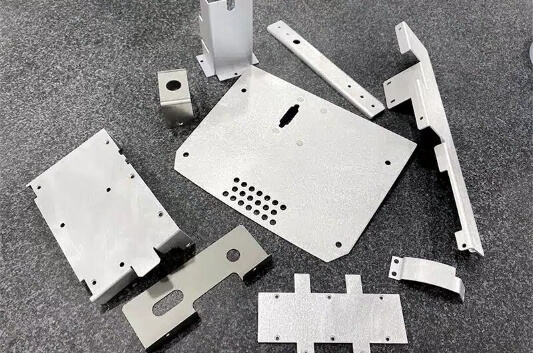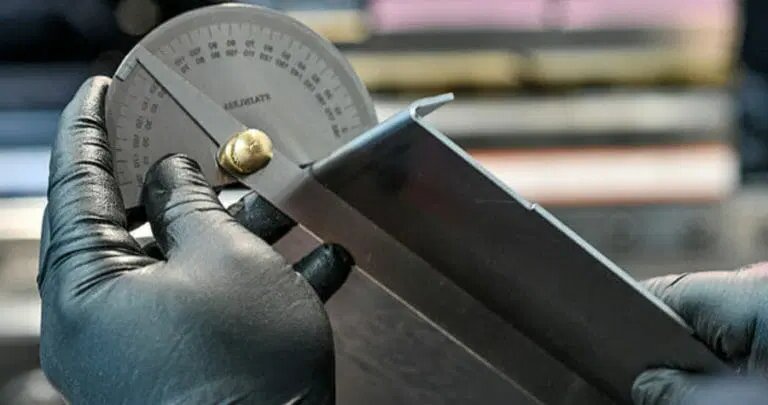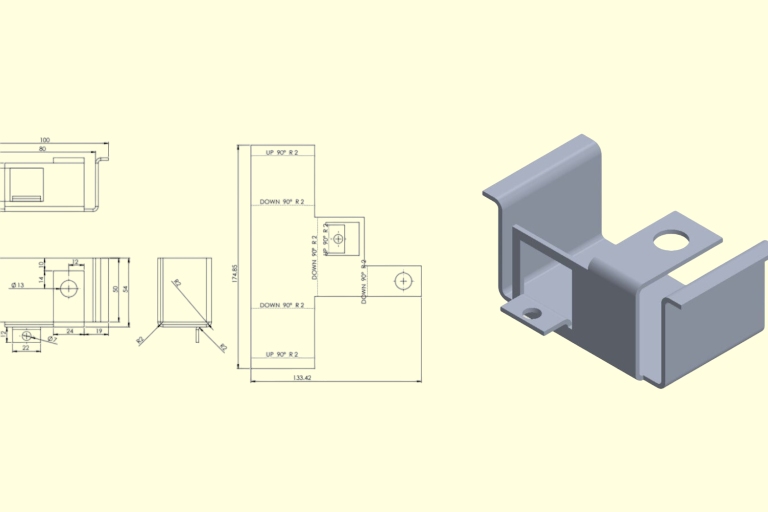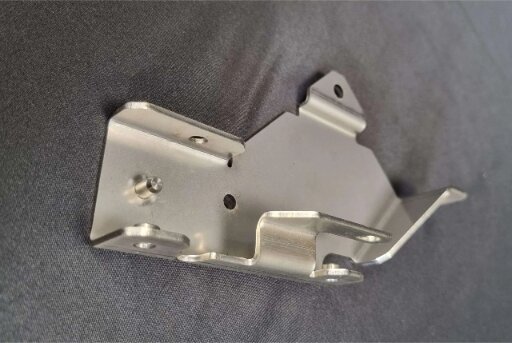대부분의 사람들은 직접 맞춤형 부품이 필요할 때까지 제품의 금속 부품이 어떻게 만들어지는지 생각하지 않습니다. 그때부터 혼란이 시작됩니다. 품질과 속도를 보장하는 신뢰할 수 있는 제작소를 찾는 것은 부담스러울 수 있습니다. 제작소 내부에서 어떤 일이 일어나는지, 무엇을 기대해야 하는지 모를 수도 있습니다. 하지만 제작소가 어떻게 운영되는지 이해하면 올바른 제작소를 선택하는 것이 더 쉬워집니다.
이러한 워크샵에서 어떤 일이 일어나고 왜 많은 산업에서 워크샵이 중요한지 살펴보세요. 일상 생활에 얼마나 많은 영향을 미치는지 알고 나면 놀랄 것입니다.

금속 제작소란 무엇인가요?
금속 제작소는 금속 부품을 성형하는 작업장입니다. 절단, 굽힘, 용접, 조립을 통해 판금 또는 구조용 금속을 최종 제품으로 만듭니다. 작업자는 기술 도면을 따르고 레이저 커터, 프레스 브레이크, MIG 용접기 등의 도구를 사용합니다.
대부분의 상점은 고객의 디자인을 받아 원자재부터 완제품까지 모든 것을 처리합니다. 일회성 프로토타입, 소량 배치 또는 대량 생산이 포함될 수 있습니다. 이들은 정확성, 속도, 품질에 중점을 둡니다.
제작 상점과 기계 상점의 차이점
제작소와 기계 공장은 금속으로 작업하지만 서로 다른 방법을 사용합니다.
제작소는 절단, 용접, 구부리기 등 물리적 힘을 사용하여 금속을 성형합니다. 시트, 바, 튜브로 물건을 제작합니다.
기계 공장은 재료를 제거합니다. CNC 밀, 선반, 그라인더를 사용하여 단단한 블록에서 부품을 조각합니다.
간단히 말해서, 제작은 늘어나는 반면 기계 가공은 줄어듭니다. 일부 현대식 공장에서는 두 가지를 모두 수행하지만 핵심 프로세스와 도구가 다릅니다.
일반적인 제작소 유형
모든 제작소가 같은 작업을 하는 것은 아닙니다. 각 유형은 서로 다른 재료, 프로세스 또는 산업에 특화되어 있습니다. 각 유형은 다음과 같이 분류됩니다.
판금 상점
다음 사항에 중점을 둡니다. 절단, 굽힘및 판금 접합. 일반적인 작업은 다음과 같습니다. 인클로저, 괄호, 그리고 캐비닛.
구조용 철골 상점
보, 기둥, 무거운 프레임을 만들고 그 부품은 건물, 교량 또는 기계에 자주 사용됩니다.
용접 상점
이들은 금속 부품을 결합하는 데 특화되어 있습니다. 일부 상점에서는 용접 다른 제작자를 위해
맞춤 작업 상점
이들은 독특하거나 일회성 작업을 맡습니다. 이러한 상점은 고객과 긴밀히 협력하여 특정 디자인 요구 사항을 충족합니다.
풀 서비스 제작 상점
모든 디자인 작업을 수행합니다, 프로토타이핑, 레이저 절단용접, 마무리 손질, 그리고 집회. 한 지붕 아래에서 전체 생산 프로세스를 처리합니다.

제작소는 어떤 일을 하나요?
제조 공장은 원자재를 기능성 부품으로 변환합니다. 그 과정을 단계별로 설명합니다.
절단
일반적으로 절단은 첫 번째 단계입니다. 원재료를 사용 가능한 작은 조각으로 만듭니다.
상점에서는 레이저 커터, 플라즈마 커터, 가위와 같은 도구를 사용하여 금속판, 튜브 또는 철근을 빠르고 정확하게 절단합니다.
레이저 커팅은 깔끔한 가장자리와 섬세한 작업을 위한 표준입니다. 플라즈마 절단 는 두꺼운 소재에 잘 맞습니다. 가위는 직선적이고 빠른 절단에 가장 적합합니다.
성형 및 구부리기
절단 후에는 금속을 구부리거나 모양을 만들어야 하는 경우가 많습니다.
상점에서는 프레스 브레이크와 롤러를 사용하여 이 작업을 수행합니다. 프레스 브레이크는 힘과 다이를 사용하여 금속을 모양으로 밀어냅니다. 롤러는 금속을 원호 또는 원통 모양으로 구부립니다.
이 단계에서는 최종 디자인의 각도, 접힘 및 곡선을 만듭니다. 정확한 구부림은 부품의 모양과 기능을 만드는 데 핵심입니다.
용접
용접은 두 개 이상의 금속 조각을 결합하는 작업입니다. 이 단계는 단일 시트 또는 막대로 부품을 만들 수 없을 때 필요합니다.
MIG, TIG 및 스폿 용접이 일반적입니다. 각각은 재료 유형, 부품 두께 및 디자인에 따라 다르게 사용됩니다.
좋은 용접은 튼튼하고 깨끗합니다. 시각적 및 안전 요구 사항을 충족하면서 부품을 함께 고정합니다.
가공
일부 부품에는 엄격한 공차 또는 세부적인 특징이 필요합니다. 이때 가공이 필요합니다.
가공은 구멍, 슬롯 또는 매끄러운 표면을 만들기 위해 소량의 금속을 제거합니다. 제작소에서는 드릴, 밀 또는 선반을 사용할 수 있습니다.
이 단계는 용접 또는 벤딩 후에 자주 사용됩니다. 부품이 정확한 크기와 모양 요구 사항을 충족하는지 확인합니다.
집회
부품을 자르고, 구부리고, 용접하고, 가공하면 부품이 조립됩니다.
조립에는 나사, 리벳, 볼트 또는 용접이 포함될 수 있습니다. 일부 상점에서는 전자 장치, 경첩 또는 패널을 추가하기도 합니다.
완전한 어셈블리는 고객에게 바로 사용할 수 있는 제품 또는 하위 어셈블리를 제공합니다. 시간을 절약하고 추가 공급업체의 필요성을 줄일 수 있습니다.
마무리 손질
마감 처리는 부품을 보호하고 외관을 개선합니다.
상점은 다음을 수행할 수 있습니다. 광택, 파우더 코팅페인트 또는 양극산화 표면. 일부 마감재는 내식성을 더합니다. 다른 마감재는 매끄럽거나 반짝이는 느낌을 줍니다.
마무리 작업에는 날카로운 모서리나 때를 제거하기 위한 디버링과 청소도 포함됩니다. 이 마지막 단계는 품질 표준과 사용자 요구 사항을 충족하는 데 도움이 됩니다.
제작 공장에서 사용되는 도구 및 장비
제조 공장에서는 특수 장비를 사용하여 원자재를 정밀 부품으로 가공합니다. 이를 가능하게 하는 주요 기계에 대해 알아보세요.
절단 도구
가장 일반적인 유형은 레이저 커터, 플라즈마 커터, 워터젯입니다. 레이저 커터는 정밀하고 깨끗하며 세밀한 모양을 만드는 데 가장 적합합니다. 플라즈마 커터는 두꺼운 금속을 빠르게 처리합니다. 워터젯은 열 없이 절단하므로 섬세한 재료에 적합합니다.
성형 장비
프레스 브레이크는 금속판을 각도나 곡선으로 구부립니다. 롤러는 금속을 원형 또는 곡선 형태로 성형합니다. 이 기계는 압력을 사용하여 재료를 깨뜨리지 않고 성형합니다.
용접 기계
MIG, TIG 및 스폿 용접기가 표준입니다. MIG는 빠르고 일반적인 작업에 적합합니다. TIG는 얇거나 섬세한 부품을 더 잘 제어할 수 있습니다. 스폿 용접은 판금 작업에 자주 사용됩니다.
가공 도구
CNC 밀과 선반은 정밀하거나 공차가 좁은 부품의 소재를 제거합니다. 드릴, 태핑 머신, 그라인더는 표면을 마감하거나 구멍을 만드는 데 도움이 됩니다.
조립 도구
여기에는 리벳 건, 토크 렌치, 클램프 및 수공구가 포함됩니다. 일부 상점에서는 용접이나 조립 중에 부품을 고정하기 위해 고정 장치를 사용합니다.
마무리 도구
디버링 기계, 샌더, 연마 휠은 모서리를 매끄럽게 하고 표면 품질을 개선합니다. 파우더 코팅 부스나 페인트 건과 같은 코팅 시스템은 보호 층을 추가합니다.

제작소에서는 무엇이 만들어지나요?
제작소에서는 우리가 매일 사용하는 수많은 품목을 생산합니다. 가장 일반적인 제품 카테고리를 살펴보겠습니다.
건설용 구조 부품
이는 건물과 인프라의 뼈대를 형성합니다:
- 초고층 빌딩용 강철 I형 철골 빔
- 교량 지지 트러스
- 계단 및 난간
- 산업용 플랫폼 프레임
전자제품용 인클로저 및 캐비닛
정밀 금속 하우징이 민감한 장비를 보호합니다:
- 데이터센터용 서버 랙
- 전기 제어 패널
- 의료기기 케이스
- 통신 장비 보호소
자동차 및 항공우주 부품
내구성이 뛰어나고 가벼운 차량용 부품:
- 섀시 프레임 및 브래킷
- 배기 시스템 구성 요소
- 항공기 내부 패널
- 엔진룸 부품
맞춤형 프로토타입 및 소규모 배치 실행
고유한 요구 사항을 위한 전문 솔루션:
- 일회성 기계 부품
- 제품 개발 프로토타입
- 레거시 장비의 교체 구성 요소
- 한정판 제작 실행
제작소는 어떻게 운영되나요?
제작소는 품질과 효율성을 보장하기 위해 정밀한 워크플로우를 따릅니다. 다음은 일반적인 단계별 프로세스입니다.
견적 및 디자인 검토
고객이 도면이나 3D 모델을 보내면 프로세스가 시작됩니다. 스토어에서 디자인을 검토하여 실현 가능성과 재료 사용 여부를 확인합니다.
그런 다음 비용, 리드 타임 및 프로세스 단계가 포함된 견적을 준비합니다. 상점에서는 기능을 개선하거나 비용을 절감하기 위한 변경 사항을 제안할 수 있습니다.
엔지니어링 및 자재 계획
주문이 승인되면 엔지니어링 팀은 절단, 절곡 및 용접을 통해 기계와 작업자를 안내하는 세부 파일을 준비합니다.
동시에 공장은 원자재를 주문하고 작업 일정을 잡습니다. 이 단계를 통해 생산이 시작될 때 모든 것이 준비되도록 합니다.
제작 및 품질 검사
이제 공장에서 절단, 성형, 용접 및 기계 가공이 시작됩니다. 작업자들은 도면을 면밀히 따릅니다. 기계는 크기와 모양에 대한 정확한 값으로 설정됩니다.
각 단계마다 품질 검사가 이루어집니다. 기술자가 측정, 용접 및 표면 마감을 검사하여 실수가 진행되지 않도록 방지합니다.
포장 및 배송
부품이 완성되고 승인되면 포장 단계로 넘어갑니다. 상점에서는 폼, 비닐 랩 또는 상자로 품목을 보호합니다.
고객 지침에 따라 부품에 라벨을 부착하고 적재하여 배송합니다. 일부 상점은 현지 배송을 제공하는 반면 다른 상점은 전 세계로 배송합니다.

금속 뒤에 숨은 사람들
모든 제작소에는 숙련된 전문가들이 함께 일하고 있습니다. 부품을 올바르게 제작하기 위해 누가 어떤 일을 하는지 알아보세요.
용접공, 제작자 및 기계공
실무 전문가들이 직접 자료를 다루고 있습니다:
- 용접기 다양한 기술(MIG, TIG, 스틱)을 사용하여 금속 결합
- 제작자 프레스 브레이크, 롤러 및 절단기 작동
- 기계 기술자 드릴링, 밀링 및 마감 작업 처리
- 모두 상세한 작업 지침과 청사진을 따릅니다.
엔지니어 및 디자이너
기술적 문제 해결사:
- 설계 엔지니어 개념을 제조 가능한 설계로 전환
- 프로세스 엔지니어 최적의 제작 방법 결정
- CAD 기술자 상세한 디지털 모델 생성
- 중첩 전문가 재료 사용 최적화
품질 검사자 및 프로젝트 관리자
품질 및 타임라인 가디언:
- 검사자 캘리퍼스, CMM 및 게이지를 사용하여 치수 확인
- QC 관리자 ISO 및 기타 품질 표준 유지
- 프로젝트 관리자 워크플로 및 마감일 조정
- 안전 책임자 OSHA 규정 준수 보장
공급망 및 물류 담당자
비하인드 스토리를 소개합니다:
- 구매 에이전트 최적의 가격으로 원자재 조달
- 재고 관리자 재고 수준 추적
- 배송 코디네이터 적시 배송 준비
- 고객 서비스 담당자 주문 업데이트 및 문의 처리
올바른 제작소를 선택하는 방법은?
올바른 제작소를 선택하는 것은 비용, 리드 타임, 제품 품질에 영향을 미칩니다. 좋은 제작소는 기술적 요구 사항을 충족하고 단순한 공급업체가 아닌 파트너처럼 일합니다. 커밋하기 전에 확인해야 할 주요 사항은 다음과 같습니다.
경험 및 인증
배경부터 시작하세요. 비즈니스에 종사한 지 얼마나 되었나요? 해당 부품이나 업계에 대한 경험이 있나요?
ISO 9001, AWS 또는 AS9100과 같은 인증은 엄격한 품질 시스템을 준수하고 있음을 보여줍니다. 이러한 인증은 항공우주나 의료와 같은 산업에서 더욱 중요합니다.
디자인과 제작을 모두 이해하는 팀을 찾으세요. 이렇게 하면 오류를 방지하고 제품을 개선하는 데 도움이 됩니다.
장비 및 기능
작업장에 작업에 적합한 기계가 있는지 확인하세요. 모든 공장에서 두꺼운 판재, 미세 절단 또는 엄격한 공차를 처리할 수 있는 것은 아닙니다.
레이저 커터, 프레스 브레이크, CNC 기계 및 마감 도구에 대해 문의하세요. 자체적으로 처리하는 서비스가 많을수록 프로젝트가 더 빠르고 원활하게 진행될 수 있습니다.
확장할 수 있는지 확인하세요. 프로토타입이 대규모 주문으로 이어진다면 이를 따라잡을 수 있어야 합니다.
처리 시간 및 커뮤니케이션
빠른 서비스는 상점이 연락을 유지하는 경우에만 작동합니다. 견적에 얼마나 걸리는지 물어보세요. 작업이 시작되면 업데이트를 제공하는지 확인하세요.
신속하게 대응하고 작업하기 쉬운 상점. 또한 배송 후가 아닌 조기에 문제를 해결할 가능성이 더 높습니다.
견고한 매장은 속도와 정확성의 균형을 유지합니다. 품질을 희생하면서까지 서두르지 않습니다.
포트폴리오 및 고객 피드백
과거 작품의 사진이나 샘플을 요청하세요. 이를 통해 아티스트의 작업 범위와 마감 품질을 파악할 수 있습니다.
온라인 리뷰를 확인하거나 추천을 요청하세요. 좋은 상점에는 단골 고객과 긍정적인 피드백이 있을 것입니다.
고객 서비스, 세심한 배려, 안정적인 배송은 기계만큼이나 중요합니다.
결론
제조 공장은 원재료인 금속이 실제 제품이 되는 곳입니다. 이곳에서는 절단, 절곡, 용접, 가공, 조립을 모두 한 지붕 아래에서 처리합니다. 이러한 공장은 건설, 전자, 자동차, 항공우주와 같은 산업을 지원합니다.
각 매장은 숙련된 팀, 강력한 도구, 단계별 워크플로우에 의존합니다. 견적부터 배송까지 모든 단계는 정확성, 속도, 고객의 니즈에 초점을 맞춥니다.
금속 부품을 빠르고 정확하게 제작해야 하나요? 그림이나 아이디어를 보내주세요.-검토 후 빠른 시간 내에 정확한 견적을 제공해 드립니다. 추측이 필요 없습니다. 정직한 답변과 양질의 결과만 제공합니다.
안녕하세요, 저는 케빈 리입니다

지난 10년 동안 저는 다양한 형태의 판금 제작에 몰두해 왔으며 다양한 워크숍에서 얻은 경험에서 얻은 멋진 통찰력을 이곳에서 공유했습니다.
연락하세요

케빈 리
저는 레이저 절단, 굽힘, 용접 및 표면 처리 기술을 전문으로 하는 판금 제조 분야에서 10년 이상의 전문 경험을 갖고 있습니다. Shengen의 기술 이사로서 저는 복잡한 제조 문제를 해결하고 각 프로젝트에서 혁신과 품질을 주도하는 데 최선을 다하고 있습니다.




